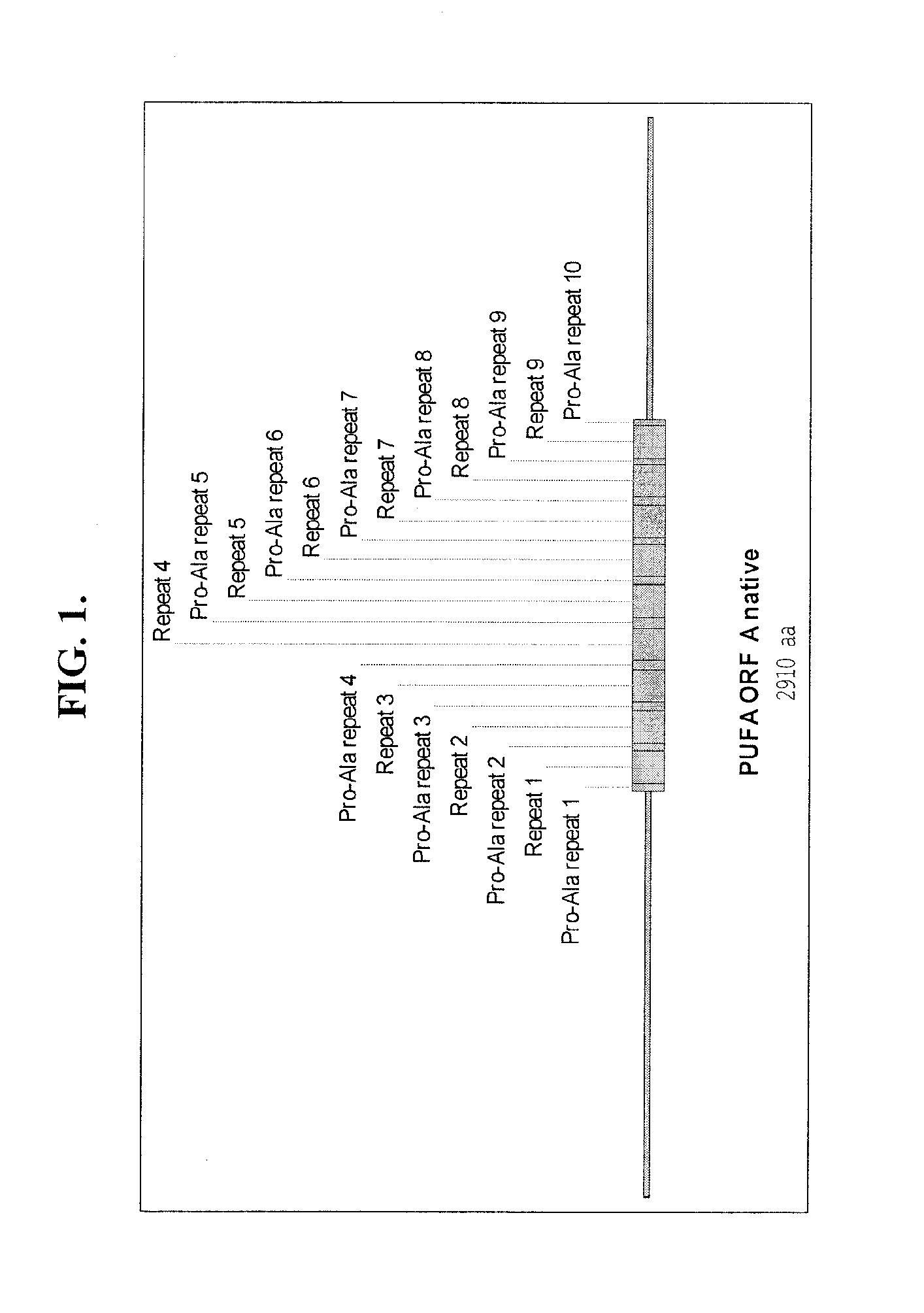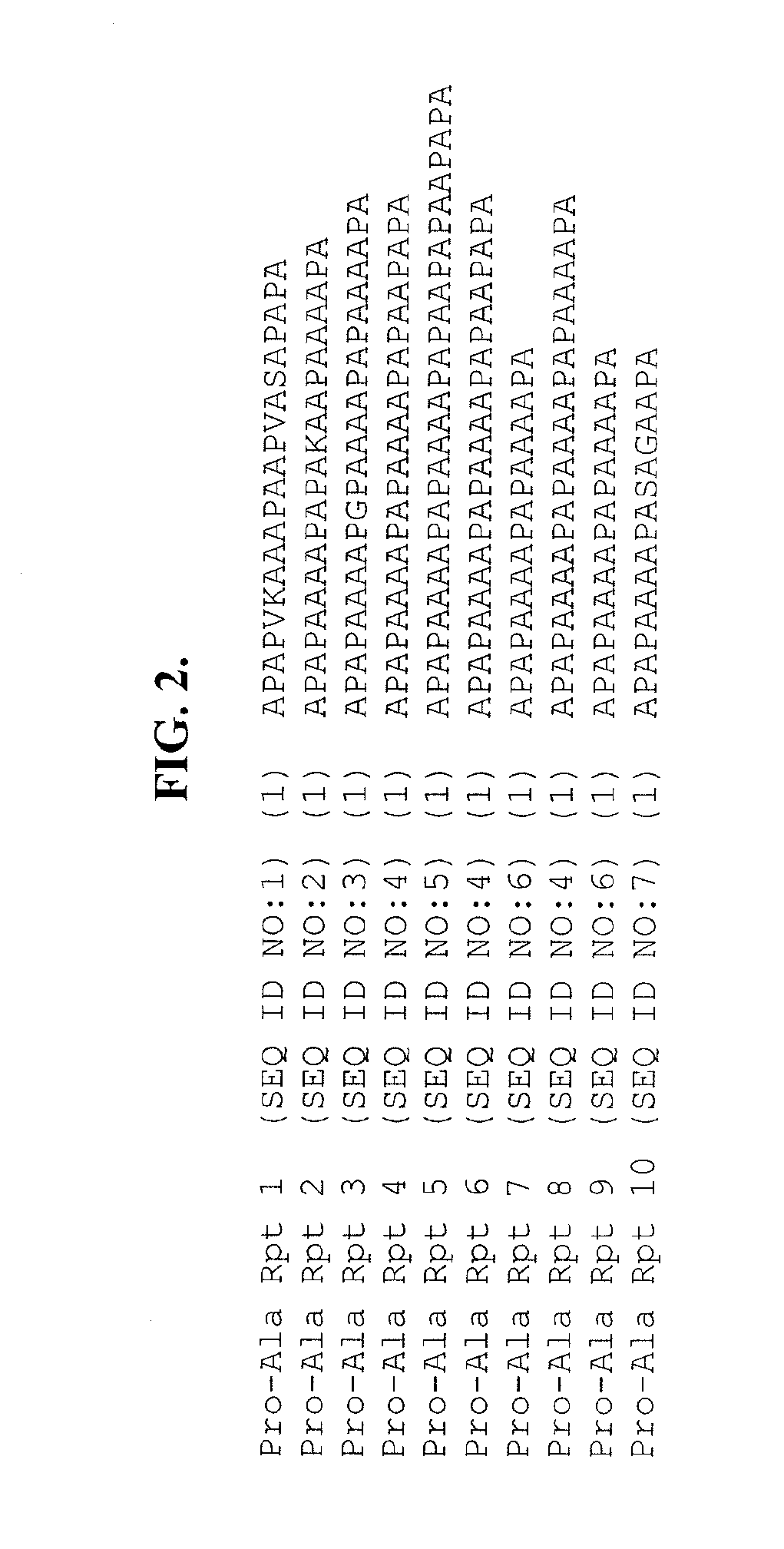Process for designing diverged, codon-optimized large repeated DNA sequences
a dna sequence and codon technology, applied in the field of optimizing gene expression, can solve the problems of limiting the availability of trna, limiting the use of rare codons, and arguing over general strategies for optimizing, so as to ensure codon and sequence diversity
- Summary
- Abstract
- Description
- Claims
- Application Information
AI Technical Summary
Benefits of technology
Problems solved by technology
Method used
Image
Examples
example 1
Codon-Optimization of a Coding Sequence Containing Large Repeated DNA Sequences
[0135]To exemplify the optimization of a nucleic acid sequence encoding a polypeptide comprising amino acid repeat regions, a Brassica napus-optimized coding region was designed for the protein encoded by “ORFA” of Schizochytrium polyunsaturated fatty acid (PUFA) synthase.
[0136]The structure of the protein encoded by “ORFA” of Schizochytrium PUFA synthase is depicted in FIG. 1. The protein comprises 10 repeated “Pro-Ala” domains, ranging in size from 17 to 29 amino acids (SEQ ID NOs:1-10 and FIG. 2). Interspersed between the repeated Pro-Ala domains (see FIG. 1) are nine longer repeated sequence domains comprising 87 amino acids (SEQ ID NOs:11-19 and FIG. 3). The amino acid sequences of these repeats vary at only four positions and there are only two amino acid choices at each of the variant positions. CLUSTALW™ analyses of the amino acid sequences of the nine repeats (FIG. 3) generated a homology value o...
example 2
Expression of an Optimized Coding Sequence Containing Large Repeated DNA Sequences
[0146]The DNA sequence for the entire optimized coding sequence as designed in Example 1 is synthesized by a commercial vendor according to standard industry practice.
[0147]The synthesized oligonucleotide molecule consisting of the entire optimized coding sequence is introduced into a B. napus cell to produce a B. napus cell comprising the optimized coding sequence, for example, by ligation of the oligonucleotide into an appropriate vector and subsequent Agrobacterium-mediated transformation.
[0148]The B. napus cell comprising the optimized coding region expresses the protein encoded by Schizochytrium PUFA synthase ORFA at levels higher than in a B. napus cell comprising the native coding sequence of Schizochytrium PUFA synthase ORFA.
example 3
B. napus Plants Comprising an Optimized Coding Sequence Containing Large Repeated DNA Sequences
[0149]The B. napus cell comprising the optimized coding sequence comprising diverged, codon-optimized amino acid repeat regions produced in Example 2 is utilized to regenerate a B. napus plant. The B. napus plant is then propagated to produce progeny that comprise the optimized coding sequence.
[0150]While the invention may be susceptible to various modifications and alternative forms, specific embodiments have been shown by way of example in the drawings and have been described in detail herein. However, it should be understood that the invention is not intended to be limited to the particular foul's disclosed. Rather, the invention is to cover all modifications, equivalents, and alternatives falling within the scope of the invention as defined by the following appended claims and their legal equivalents.
PUM
 Login to View More
Login to View More Abstract
Description
Claims
Application Information
 Login to View More
Login to View More - R&D
- Intellectual Property
- Life Sciences
- Materials
- Tech Scout
- Unparalleled Data Quality
- Higher Quality Content
- 60% Fewer Hallucinations
Browse by: Latest US Patents, China's latest patents, Technical Efficacy Thesaurus, Application Domain, Technology Topic, Popular Technical Reports.
© 2025 PatSnap. All rights reserved.Legal|Privacy policy|Modern Slavery Act Transparency Statement|Sitemap|About US| Contact US: help@patsnap.com



